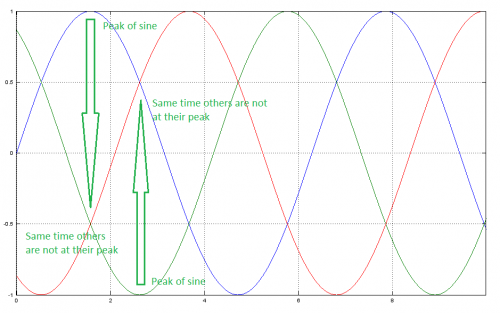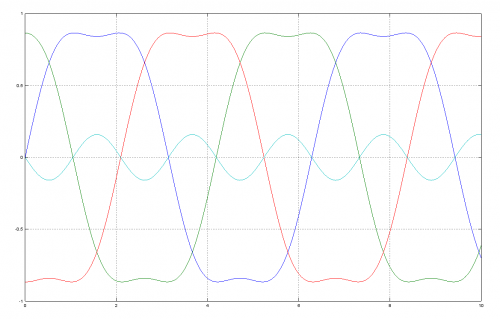Latest innovation made to IONI firmware allows generating 15% higher output voltage for 3 phase AC motors which in practice means 15% greater maximum possible speed of motor. This is achieved by by altering the duty cycle generation of power stage so that it’s being utilized better for this kind of waveforms.
By looking the typical 3-phase motor voltage waveforms below, one can notice the peaks of sine waves occur one-at-a-time which means there is some headroom in the opposing polarity waves.

Standard 3 phase sinusoidal waveforms. Range from 1 to -1 means it uses full output voltage span available in drive (i.e. 0V to 55V)
We can utilize these empty gaps by shifting all three waves up and down so that empty gaps become filled.

Same signals with summed third harmonic (cyan) to all phase values. This reduces peak amplitude of all signals by 15% without affecting to any phase-to-phase waveform shape or amplitude. In other words, motor sees no difference between this and the original.
After this step, we can multiply them by 1.15 without exceeding the maximum range of +/-1. This method has been tested and it works flawlessly. Same smoothness but just a bit higher speed range is available from the drive. The trick effectively does same as increasing drive supply voltage from 55 V to 64 V without actually increasing it.
This, and as many as possible, new features of IONI will be ported back to ARGON as soon as the IONI is out.

Very cool! This wouldn’t sacrifice efficiency for the higher speed like field weakening would it? Would it be possible to add field weakening as well?
Regards,
Jason
Another question! Any chance of extending this feature all the way back to VSD-E and XE?
Thanks,
Jason
Sure, no big deal actually. We’ll probably do that as well. Any other good ideas for VSD-E? :)
I’m out of ideas now :) Looking forward to the high current replacement for VSD-E actually!
Field weakening would work without any difficulties as well. However, field weakening generally has few shortcomings that I don’t like:
* no clear procedure for tuning it
* also position/velocity servo gains above certain speed threshold would not stay constant
* risk of damaging hardware if drive is being disabled or faulted at high speed (motor generates voltage that is greater than HW maximum)
Hi, I am about to finally attach my VSD-E units to my CNC. I am running a 70V 20A power supply so I am under the 80volt for the VSD-E, but to be honest I am not sure about the following.
VSD-E vs VSD-XE – is this a difference in the heat sink and the max current?
Is there also a difference between an 80v and 160v capable VSD – what distinguishes that?
Thanks
Richard
Also, is the 2.11 with magic trick firmware considered safe? Has it been well tested? Thanks
just to clarify, my point is I do not actually know which model I have , I suspect they are all VSD-XE as they all have the finned channeled heatsink but I am not sure if they are or not and does the heatsink also infer that these are later 160v units or are they 80v version…….. Who knows one day I might want to use a higher voltage….. cheers